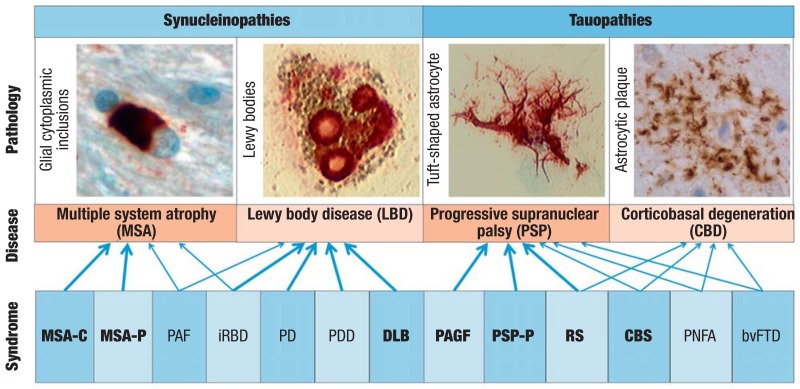Figure 1.
Disease definitions. Neurodegenerative parkinsonian syndromes are synucleinopathies or tauopathies which are defined by the intracellular aggregates of the alpha-synuclein or tau protein. The disease entities multiple system atrophy (MSA), dementia with Lewy bodies (DLB), progressive supranuclear palsy (PSP), and corticobasal degeneration (CBD) are characterized neuropathologically by glial cytoplasmic inclusions, Lewy bodies, tuft-shaped astrocytes, or astrocytic plaques, respectively. The resulting clinical syndromes: MSA with predominantly cerebellar symptoms (MSA-C), MSA with predominantly parkinsonian symptoms (MSA-P), pure autonomic failure (PAF), idiopathic rapid eye movement sleep behavior disorder (iRBD), Parkinson’s disease (PD), Parkinson’s disease with dementia (PDD), dementia with Lewy bodies (DLB), pure akinesia with gait freezing (PAGF), PSP with predominantly parkinsonian symptoms (PSP-P), Richardson’s syndrome (RS), corticobasal syndrome (CBS), progressive non-fluent aphasia (PNFA), or the behavioral variant of frontotemporal dementia (bvFTD). PD and PDD are the most common parkinsonian syndromes. From a clinical perspective the syndromes in bold print—MSA-C, MSA-P, DLB, PAGF, PSP-P, RS, and CBS—are classed among the atypical parkinsonian syndromes. The other syndromes are characterized primarily by non-motor symptoms. The estimated positive predictive value (PPV) of the clinical syndromes for an underlying neuropathological disease entity is indicated by arrows (bold: high PPV; regular: medium to low PPV)

